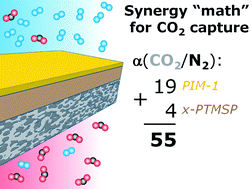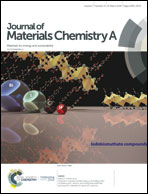Synergistic enhancement of gas selectivity in thin film composite membranes of PIM-1
Abstract
High free volume glassy polymers or polymers of intrinsic microporosity such as poly[1-trimethylsilyl-1-propyne] (PTMSP) and polybenzodioxane (PIM-1) are extra high gas permeability membrane materials. One of their major drawbacks is low gas selectivity. In this study, thin film composite (TFC) membranes have been developed with high CO2 permeance and superior CO2/N2 selectivity due to a strong synergistic effect. The TFC membranes, comprising a thin layer (0.29–0.42 μm) of PIM-1 atop a cross-linked PTMSP gutter layer (2.07–3.44 μm) on a porous backing material, were fabricated by coating PIM-1 solution on the cross-linked PTMSP support. A key element is that for coating PIM-1 a mixed solvent of chloroform and trichloroethylene (1 : 1) was successfully implemented for the first time. All membrane samples demonstrated a strong synergistic enhancement of CO2/N2 selectivity (α = 35.8–55.7) compared to PIM-1 (α = 18.5) and cross-linked PTMSP (α = 3.7). SEM, TEM and laser interferometry studies revealed that the synergistic enhancement of gas selectivity in the TFC membranes is most likely due to the creation of a very thin boundary layer between PIM-1 and the cross-linked PTMSP gutter layer. The aged TFC membranes (after three months) showed a severe drop in gas permeance while keeping nearly the same high selectivity. Thus, future success in the prevention of polymer physical aging, together with the synergy effect in selectivity reported for the first time in this work, will give new opportunities for application of polymers of intrinsic microporosity.



 Please wait while we load your content...
Please wait while we load your content...